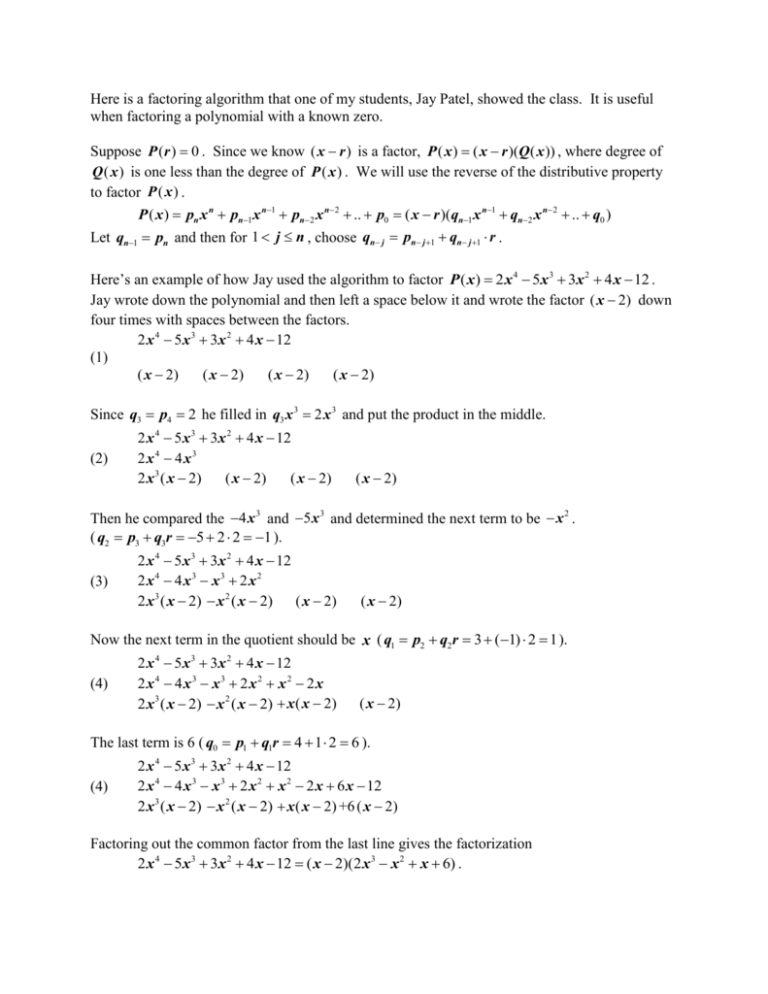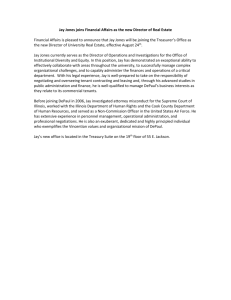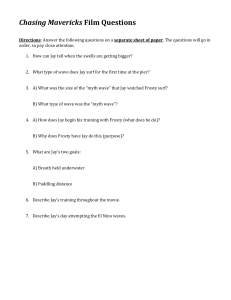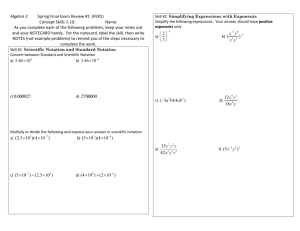Here is a factoring algorithm that one of my students, Jay Patel
advertisement

Here is a factoring algorithm that one of my students, Jay Patel, showed the class. It is useful when factoring a polynomial with a known zero. Suppose P ( r ) 0 . Since we know ( x r ) is a factor, P ( x ) ( x r )(Q ( x )) , where degree of Q ( x ) is one less than the degree of P ( x ) . We will use the reverse of the distributive property to factor P ( x ) . P ( x ) pn x n pn1 x n1 pn2 x n2 .. p0 ( x r )(qn1 x n1 qn2 x n2 .. q0 ) Let qn1 pn and then for 1 j n , choose qn j pn j 1 qn j 1 r . Here’s an example of how Jay used the algorithm to factor P ( x ) 2 x 4 5 x 3 3x 2 4 x 12 . Jay wrote down the polynomial and then left a space below it and wrote the factor ( x 2) down four times with spaces between the factors. 2 x 4 5 x 3 3 x 2 4 x 12 (1) ( x 2) ( x 2) ( x 2) ( x 2) Since q3 p4 2 he filled in q3 x 3 2 x 3 and put the product in the middle. (2) 2 x 4 5 x 3 3 x 2 4 x 12 2 x4 4 x3 ( x 2) ( x 2) 2 x 3 ( x 2) ( x 2) Then he compared the 4x 3 and 5x 3 and determined the next term to be x 2 . ( q2 p3 q3r 5 2 2 1 ). (3) 2 x 4 5 x 3 3 x 2 4 x 12 2 x4 4 x3 x3 2 x2 ( x 2) 2 x 3 ( x 2) x 2 ( x 2) ( x 2) Now the next term in the quotient should be x ( q1 p2 q2r 3 (1) 2 1 ). (4) 2 x 4 5 x 3 3 x 2 4 x 12 2 x4 4 x3 x3 2 x2 x2 2 x 2 x 3 ( x 2) x 2 ( x 2) x ( x 2) ( x 2) The last term is 6 ( q0 p1 q1r 4 1 2 6 ). (4) 2 x 4 5 x 3 3 x 2 4 x 12 2 x 4 4 x 3 x 3 2 x 2 x 2 2 x 6 x 12 2 x 3 ( x 2) x 2 ( x 2) x ( x 2) +6 ( x 2) Factoring out the common factor from the last line gives the factorization 2 x 4 5 x 3 3x 2 4 x 12 ( x 2)(2 x 3 x 2 x 6) . Jay learned the algorithm during his schooling in India. The factoring problem arose in a x2 4 calculus when attempting to evaluate lim 4 . Jay was the only student x 2 2 x 5 x 3 3 x 2 4 x 12 who was able to factor the denominator using any method. No one even considered division or trying systematically to find the missing factor. The class absolutely loved the method and asked for more examples for practice. Jay named the algorithm, Jaypooo’s Method. Dorothy Hawkes, Solano Community College











